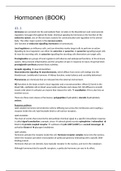Summary
Summary CH41 Hormones
- Course
- Institution
- Book
Summary of the topic of hormones from Campbell Biology a Global Approach, 11th edition. This summary includes notes of accompanying MasteringBiology assignments, lectures and any lectures. Summary of the topic of hormones from Campbell Biology a Global Approach, 11th edition. This summary includes...
[Show more]




